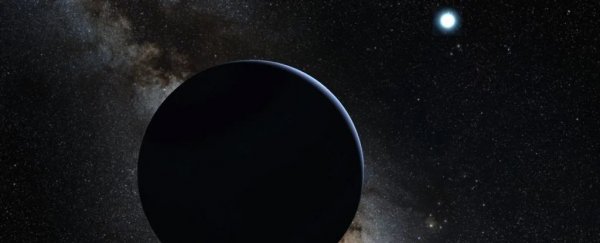A new search for the elusive Planet Nine has once again yielded nary a sniff of a sneaky outer Solar System body.
Although the hypothetical object continues to evade detection, a six-year search in millimeter wavelengths has allowed astronomers to rule out an object with Planet Nine's predicted properties in a large swathe of the southern sky.
The search also yielded some candidate objects that might be interesting to follow up in future surveys.
"No significant detections are found, which is used to place limits on the millimeter-wave flux density of Planet Nine over much of its orbit," the researchers wrote in their paper.
"We also provide a list of the 10 strongest candidates from the search for possible follow-up. More generally, we exclude (at 95 percent confidence) the presence of an unknown solar system object within our survey area."
Planet Nine is one of the more intriguing Solar System propositions in recent years. For decades, scientists have speculated about the existence of a hidden planet in the far reaches of the Solar System, but it reached a new pitch in 2016 with the publication of a paper by astronomers Mike Brown and Konstantin Batygin of Caltech.
In their paper, Brown and Batygin suggested that small objects in the outer Solar System's Kuiper Belt were orbiting oddly, as though pushed into a pattern under the gravitational influence of something large. That something, they concluded, could be a previously unknown planet shepherding small rocks.
Neptune was predicted in a similar way, from calculations of Uranus' orbit, before astronomers discovered it using telescopes. But finding Planet Nine is a lot more complicated than finding Neptune.
If Planet Nine is out there, calculations suggest it could be 5 to 10 times the mass of Earth, orbiting at a distance somewhere between 400 and 800 astronomical units (an astronomical unit is the average distance between Earth and the Sun; Pluto, for context, is around 40 astronomical units from the Sun).
That means it would take somewhere between 10,000 and 20,000 years to go once around the Sun.
So, Planet Nine is very far away, quite small, and cold. As a result, it probably does not reflect much sunlight at all, or give off thermal radiation (heat).
Moreover, we don't know precisely where it is in the very large sky. So the jury is out on whether it is real or not, and the topic is one of pretty intense and interesting debate.
Led by Sigurd Naess of the Flatiron Institute's Center for Computational Astrophysics, astronomers tried to find a hint of the planet by poring over data collected by the 6-meter Atacama Cosmology Telescope in Chile.
This telescope is designed to detect a faint signal left over from the Big Bang, called the cosmic microwave background; however, it turns out it's also sensitive enough to detect objects in the very far reaches of the Solar System.
Between 2013 and 2019 inclusive, the telescope scanned about 87 percent of the available southern sky, for distances between 300 and 2,000 astronomical units. Within that space, the telescope can detect a 5 Earth mass planet between 325 to 625 astronomical units; and a 10 Earth mass planet between 425 and 775 astronomical units.
Although the search yielded about 3,500 tentative candidates, none were statistically significant, and none could be confirmed.
Nevertheless, the team picked out the 10 strongest candidates for future study; even if they're not Planet Nine, they could still be something interesting.
Previous searches for Planet Nine have yielded really distant Solar System rocks, as well as previously unknown moons of Jupiter and Saturn.
In addition, the team's results only covered a segment of the sky and possibilities. There's still an awful lot of space out there to be covered, and there are regions in its orbit that the telescope wouldn't be able to see Planet Nine. So the non-detection isn't surprising and can't rule out the existence of the hypothetical object.
Future instruments, like the upcoming Simons Observatory in Chile, should be able to substantially widen the parameters of the search for Planet Nine, raising the possibility of detection, the researchers said.
The paper has been published in The Astrophysical Journal.
